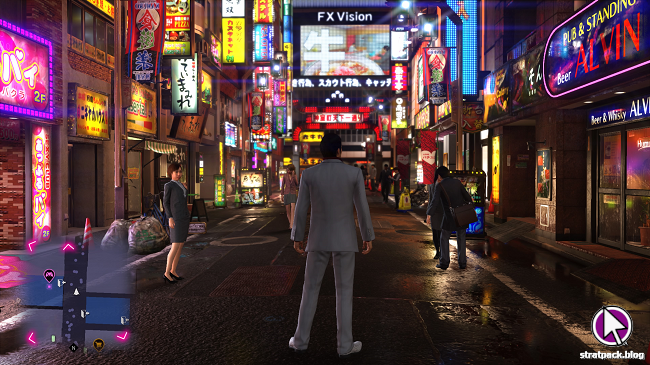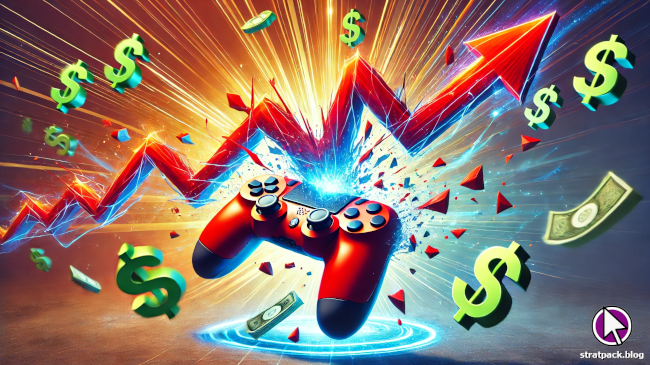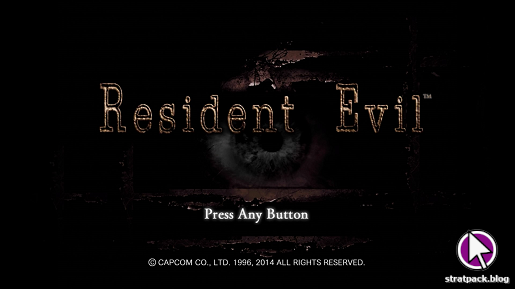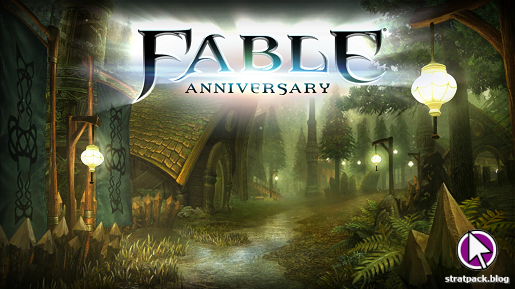
The Sims (PC) retrospective
If you think of The Sims today, you’ll likely think of the EA money printing machine and its endless conveyor belt of expansion and stuff packs. The modern games have a cutesy, sanitised face, and the bright marketing material reflects their apparent positioning as a platform for teenage girls to build their dream homes and lifestyles, rather than a semi-accurate and challenging simulation of life’s ups and downs.
That wasn’t always the case. When the original game was released in 2000, it did contain some humour (especially through Maxis’s renowned flavour text) but the game itself was an attempt to explore social and architectural themes through the most realistic recreation of life possible with the technology of the time – and as a result of its limitations, one that often strays into unsettling territory.
A virtual doll house
This was a time before video games were such big business. The Sims would certainly contribute to the industry’s growth and transformation into the corporate nightmare we know today (it eventually sold more than 11 million copies, without even considering the sequels), but at the time the game was conceived in the 1990s it wasn’t unusual for a game to be based entirely around a single designer with an interesting idea and a vision of how it might be fun for players.
In this case, that visionary was SimCity designer Will Wright. After losing his house to the 1991 Oakland firestorm, Wright began to ponder whether the process of rebuilding his home and life might in fact be a suitable basis for a game. To begin with, his concept focused on the architecture and furnishings, but it eventually evolved into the idea of a virtual doll house filled with simulated people, appraising the value and attractiveness of their surroundings and living out their lives.
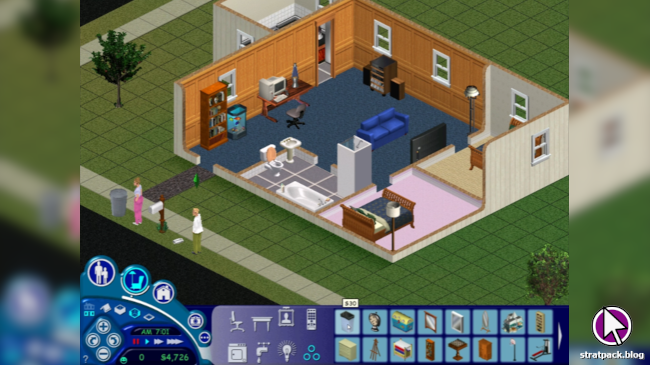
Build and Buy Mode retained these original tools, but Wright realised that controlling the Sims themselves and playing through their relationships and careers made for a more entertaining game. Even then, his company wasn’t sold on the idea. While Wright thought the concept was of natural interest (“people are fascinated with people”), Maxis didn’t think players would want to simulate household chores when video games could let them do far more exciting things they could only dream of. The Sims was even given the internal nickname “the toilet game”.
Therefore, while Wright’s vision did come to fruition following EA’s acquisition of the studio, and The Sims and its sequels would sell millions of copies and expansion packs, it’s worth remembering that original game wasn’t developed with sales optimisation in mind. This was a case of one man pursuing a concept that felt interesting to him. The game’s manual even featured a recommended reading list, detailing books on architecture, design, and planning that its creators had studied.
Fed, watered, and romanced
Even with the most basic of tutorials, The Sims is easy to pick up. Fundamentally, the game revolves around keeping Sims happy by topping up eight meters representing their hunger, bladder, fatigue, and so on by interacting with objects. Wright and his team developed a reported 14 iterations of the interface because they wanted it to be playable without reading the manual, and this would prove crucial in making it a breakout game that appealed to a near universal audience.
Beyond keeping Sims’ basic needs satisfied, The Sims is an open-ended simulation of life, with the player open to pursue marriage and children, career success, material wealth, or mastery of the arts via their virtual dolls, without the imposition of any real success or fail state by the game beyond death. This provides natural accessibility, because the next action in any given situation is normally obvious to the player due to their real-world experiences and dreams.
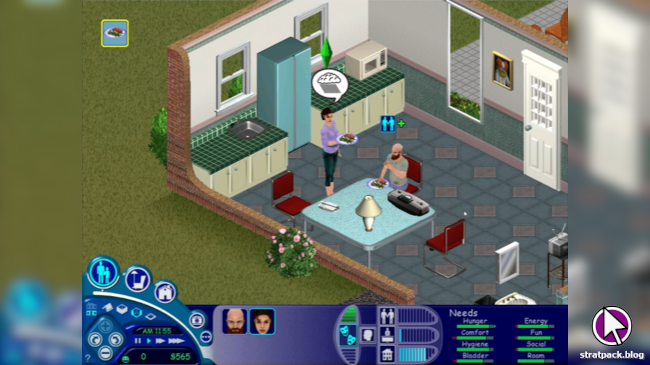
“The game suggests certain story spaces,” Wright told Rock Paper Shotgun in a 2008 interview. “We saw players presented with a game about everyday life, and they gravitated towards them. Can you kiss? Can they fall in love? Can they die? And a lot of these were just the normal parts of everyday life.”
The Sims 2 would eventually bake in generational storytelling through aspirations, wants, fears, and a full ageing model, but the formula wasn’t perfectly balanced in 2000, and the stories that emerged in The Sims were often memorable because of how rough an approximation of life it was. Even while playing for this article, my Sim had a proposal rejected because his sweetheart was too hungry, started a fire while trying cook dinner, and then immediately started a second fire when he tried again. In its heyday, these stories would spread rapidly between friends and on forums.
House of screams
An interesting facet of The Sims’ internals is the artificial intelligence exhibited by its characters. It’s easy to think of the game as player-led - I click the chair and tell my Sim to sit in it - but if that was entirely the case then a Sim left to their own devices would just stand idle until a critical need failed and they died. This would break the “living doll” illusion, so Wright and his team needed to find a way to bestow free will upon Sims that was possible to achieve on the PCs of the 1990s.
The ingenious solution they came up with - and one that might not sound too far from the truth for anybody who has studied marketing or sales - is that the heavy lifting would be done by the objects around the Sims. Any item that can provide a benefit to a nearby Sim screams this into the void, and the Sim’s role is to filter all of these signals based on the current status of their needs and their personality.
“We couldn’t make the people smart enough so we had to make the environments smarter,” Wright told IGN in 1999 as he discussed the inner workings of Sims’ minds. “All the intelligence is embedded in the object in the environments.”
It’s no coincidence, then, that to this day unattended Sims will quickly end up playing video games on the computer. Human players will often queue up mundane tasks to manage and progress their lives (cooking, taking out the rubbish, reading, cleaning the shower, and so on), and if these drive their fun meter low enough then it will be the entertainment offered by the computer that calls out the loudest, leading the Sim to choose it over reading the newspaper or sitting in an armchair.
The hedonic treadmill
Another pertinent mechanic is that by which Sims appraise the new objects you spend their hard-earned simoleons on. When you return to Live Mode after placing a new item, sometimes Sims will automatically spawn an action titled “What’s this?”. They’ll walk over to their new possession, consider it for a few seconds, and then express their opinion with full force, either yelling and applauding if they approve of your purchase or making their disdain known if they don’t.
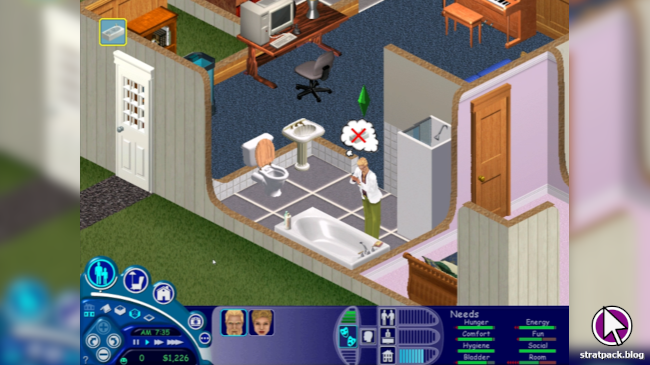
The trick behind the scenes, and the detail that introduces a real-life parallel, is that whether a Sim loves a new item or not is based upon the average value of all the other objects in the house (with penalties if they already own multiples of the same item). For a positive response, the new buy must be worth at least 20 percent more than the average value. Because this is a moving target, what impresses your Sims when they’re poor may offend them once they’re rich.
I see this as less of a critique of consumerism as a whole and more as a warning regarding the hedonic treadmill you may find yourself on if progress and material wealth are your sole objectives and focus. It’s difficult to avoid - it’s the nature of the human mind that even the shiniest new purchase will eventually fade into the background amongst your other, older possessions - but it’s worth remembering the times when you had much less and practicing gratitude for what you now have.
Behind closed doors
On a surface level, The Sims encapsulates the American Dream and the optimism of the 1950s and 1960s. Sims begin their lives with $20,000 - enough to purchase a humble home filled with low-quality belongings - and through networking, hard work, and self-improvement can earn their way to the hilltop mansion and a state-of-the-art TV set. All this is set against the wistful soundtracks of Buy and Build Mode.
What sets the game apart is a mood that alternates between mid-century consumer bliss and an unnerving sense that something is fundamentally wrong. I’ll spare you the essay on why The Sims is a parody of late-stage capitalism and foreshadows society’s collapse - I’m not part of the anti-capitalist crowd - but there is an unsettling element, partly due to technical limitations but also because of deliberate gameplay elements, that something is not right beneath the surface.
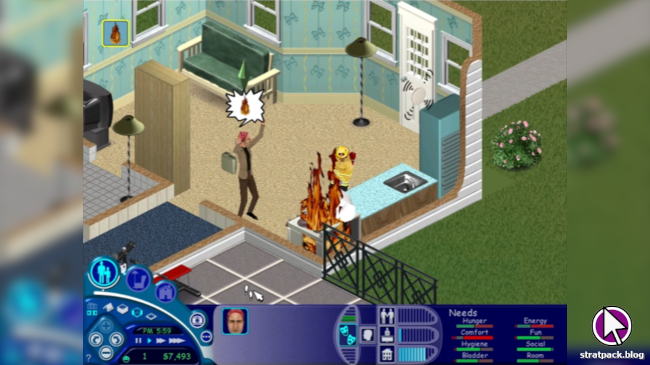
A contributing factor here is that The Sims is purposefully abstract by design. Wright knew that perfectly simulating real life wouldn’t be possible in 2000 - that’s an impossible order even with 2024 hardware - so characters’ actions often lack detail and they speak in a garbled language called Simlish. The Sims’ native tongue emulates real dialects in its sounds, but is deliberately indecipherable so players’ minds can fill in the blanks and add meaning, upping the surreal factor.
Another is that the game outwardly projects a mood similar to films like American Beauty – a suburban world where the sun is perpetually shining on the picket fences, the birds are tweeting, and the neighbours come to your door with their home cooking. The same chirpy, feel-good tone becomes jarring when your Sim has a mental breakdown and pees his pants, a burglar enters their home while they’re sleeping, or you receive an anonymous and vaguely threatening phone call.
An imperfect simulation
Complicating things further is that while the Sims’ lives might not be as bright as they appear on the surface, the same may be true of the player. For the most part, The Sims is a dream playground for the escapist who wishes for more control than they feel over their real life, but when its more sinister elements creep in they can have an uncanny quality that breaches the divide between the two.
The Sims offers a simplified view of the world. Happiness is having eaten, slept, and been to the bathroom recently. Effort bestows wealth, and Sims are told just how much they must improve for a promotion. Relationships are measured in numbers, with each interaction assigned a distinct positive or negative value. Skill progression is linear, and time spent tickling the piano keys is guaranteed to pay off.
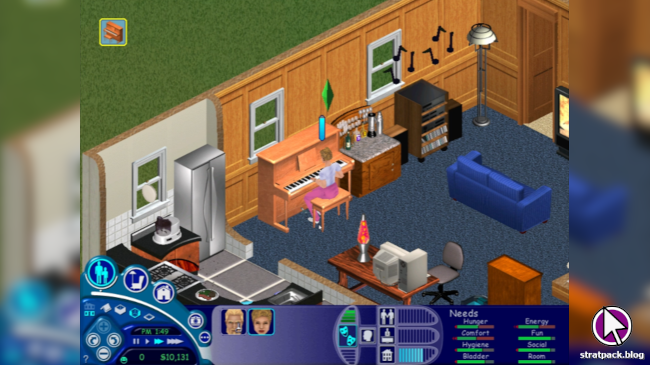
I was a child in 2000, playing the game as a way to escape my parents’ constraints and imagine my adult future, and one of reasons I drifted away from the series was a feeling I was substituting productive contribution towards my real life by indulging in a fantasy world that offered short-term entertainment but no sustainable fulfilment. The moments the melancholy undertones shone through in the music were a jarring reminder of this, making a late-night play session feel that much lonelier.
And then there are the times the game seems to go out of its way to make the player uncomfortable. The desperate screams as Sims watch their homes burn. The grave jingle that plays when a Sim passes away. The spooky music that randomly chimes in at night (even worse when you try and fail to search the lot for a ghost). There’s an undertone of menace to The Sims that seems designed to catch you out from time to time, and makes you wonder if you’re really the watcher or the watched.
A virtual box of chocolates
Life is what you make it, and so is The Sims. The last 24 years have seen players tell the stories of multi-generational families in painstaking detail, build mind-bogglingly complex dream houses, and invent ever more concerning ways to torture their little virtual people. The sequels (with the possible exception of The Sims 4) only expanded upon the possibilities and enabled further creativity.
But with success comes money, and with money comes bureaucracy and pressure. It’s been more than two decades since EA released The Sims’s earliest expansion packs, and in that time it feels like the game’s focus has shifted from life simulation towards an imagining of a perfect existence where the characters all have Pixar-style faces and it’s very hard for things to go wrong unless you want them to.
Unfortunately, The Sims has lost a lot of its original tone and character along the way. Aesthetics and pre-cooked stories seem to be the name of the game since The Sims 3, and the uncanny vibe that permeated The Sims’s gameplay has long given way to a chipper and almost childish tone that rules out anything remotely shocking - let alone the original’s ever-present sense of dread.
I’ll be honest: The Sims 2 is my favourite game in the series for playability (the systemic upgrades were worth a small sacrifice to the levels of weirdness), but The Sims will always be the most special entry. From the concept itself, to all the odd and creepy gameplay quirks, to the iconic soundtrack, nothing has come close to the unique atmosphere of Will Wright’s virtual doll house.
Further reading
The following is a list of high-quality articles and videos on The Sims, which served both as inspiration and as means to verify the little details I thought I remembered about a game from the year 2000, but needed to check weren’t fabrications of my young mind. While presented in no specific order, they are all worthy of your time.
- Dumb People, Smart Objects: The Sims and the Distributed Self
(Game Philosophy Network) - Making of: The Sims (Rock Paper Shotgun)
- The Genius AI behind The Sims (Game Maker’s Toolkit)
- The Making of The Sims (GamesRadar)
- The Sims (Wikipedia)
- The Sims interview (IGN)
- The Sims: Prima Official eGuide (Internet Archive)
- What is The Sims? (Michael Aguero)




